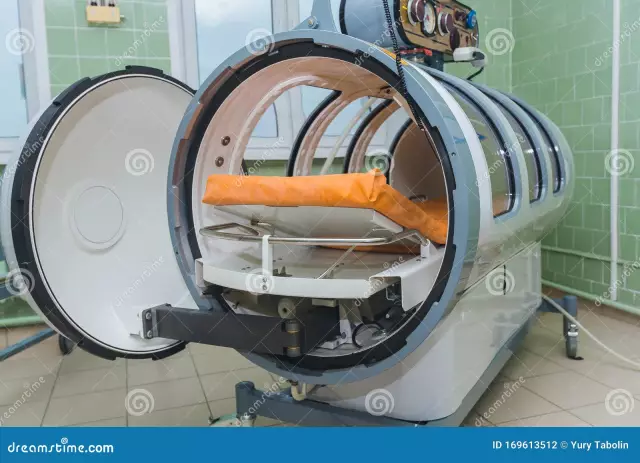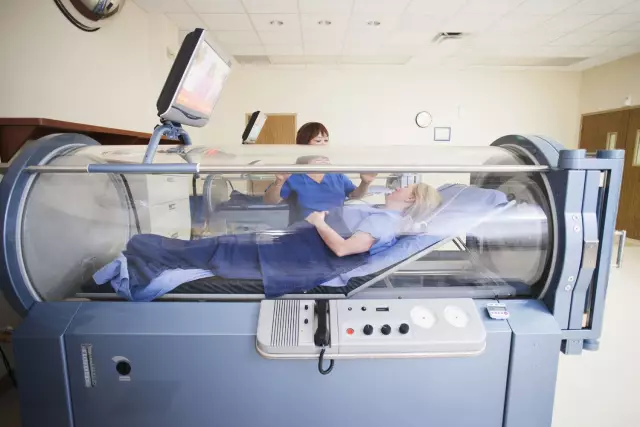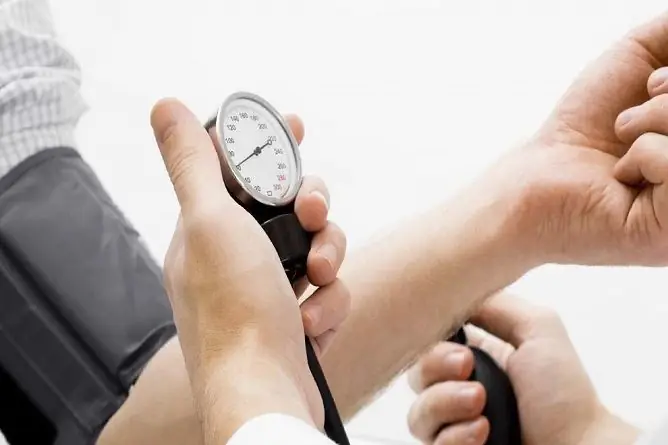- Author Rachel Wainwright [email protected].
- Public 2023-12-15 07:39.
- Last modified 2025-11-02 20:14.
Treatment in a pressure chamber - a method of hyperbaric oxygenation

Oxygen is vital for the human body; the availability of sufficient oxygen is one of the basic conditions for the normal functioning of cells. If there is not enough oxygen, hypoxia develops - oxygen starvation, which first leads to a breakdown in the activity of cells, then tissues, and then to their death.
It is known that oxygen starvation is the main cause of the development of pathological processes in tissues in any type of inflammation, therefore, hypoxia is also the basis of the mechanism for maintaining all chronic diseases. It is this mechanism that promotes, among other things, the development of cancerous tumors, since it is known that a lack of oxygen is precisely the environment favorable for malignant cells in which they feel best, freely dividing and displacing normal cells weakened by oxygen starvation. Understanding these mechanisms led to the development of one of the non-drug treatments, namely, pressure oxygen therapy, or hyperbaric oxygenation (HBO). This method of treatment was discovered a long time ago - back in 1955, and since then, being widely used in medical practice,has established itself from the very best side.
How Hyperbaric Oxygenation Works
Oxygen enters every cell of the body through the bloodstream. In case of impaired vascular patency (atherosclerotic changes, inflammatory edema, blood clots, etc.), the blood does not reach certain organs in the required quantities, which triggers the mechanism of hypoxia. And on the contrary, the ingress of oxygen into such tissues allows them to regenerate, restore those cells that can be saved, destroy and remove those cells that can no longer be restored, and grow new ones instead.
The increased pressure created artificially in the pressure chamber, with the simultaneous supply of oxygen, leads to the saturation of the blood with oxygen more than it happens under normal conditions. Saturated blood delivers it to the most distant and urgently needed organs and tissues. Having received the necessary "fuel", the cells start the mechanism of restoration of damaged tissue, and this applies to all tissues without exception - nervous, muscular, bone, cartilaginous, etc. As for adipose tissue, oxygen contributes to its normalization, during which the excess in the form of fat deposits is "burned", and the necessary fat, for example, in the composition of the myelin fibers of the nerves, is strengthened.
Oxygen treatment indications
Oxygen treatment is indicated for many diseases, which are characterized by impaired peripheral blood supply. It was already mentioned above that, in addition to the actual diseases of the cardiovascular system, circulatory disorders in the capillaries are characteristic of all chronic diseases without exception. In addition, the method of hyperbaric oxygenation is used for general strengthening of the body, strengthening the immune system, it is considered as an excellent way to prevent many diseases, including oncological pathology.
Excellent results can be achieved with oxygen treatment for the following conditions:
- Anemia;
- Diabetic foot and other circulatory disorders in the lower extremities;
- Furunculosis;
- Paradontosis;
- Diabetes;
- Scleroderma;
- Obliterating endoarteritis;
- Raynaud's disease;
- Cardiac ischemia;
- Post-infarction and post-stroke conditions;
- Chronic enterocolitis;
- Hepatitis;
- Cirrhosis of the liver;
- Acute and chronic pancreatitis;
- Diffuse toxic goiter;
- Chronic inflammatory processes in the small pelvis;
- Psoriasis;
- Bedsores;
- Hearing loss;
- Peptic ulcer of the stomach and duodenum;
- Alcohol and drug abstinence;
- Mental illnesses, accompanied by cerebral circulation insufficiency;
- Multiple sclerosis;
- Obesity;
- Rehabilitation of cancer patients after courses of chemotherapy and radiotherapy.
In addition, the method of hyperbaric oxygenation is the main method of treatment for intoxication with combustion products and other toxic substances that bind oxygen in the blood (cyanides, etc.), decompression syndrome, air embolism, gas gangrene, long-term non-healing wounds, frostbite, suffocation, all types of traumatic ischemia, including the syndrome of prolonged compression (crash syndrome).
The course of oxygen treatment helps to recover faster and avoid late complications after surgical interventions and past injuries, helps the rehabilitation of athletes after exhausting workouts, is successful in all types of fatigue, stress and is especially effective in treating insomnia. The method has no side effects, it allows to reduce and sometimes completely eliminate the drug load, and therefore it is recommended in the practice of treating childhood diseases - for the main indications the same as in adults, and for the treatment and prevention of dangerous conditions in pregnant women.
Contraindications to hyperbaric oxygenation

Unfortunately, there is no panacea yet, and oxygen treatment is no exception. There are diseases in which hyperbaric oxygenation is not recommended, as there is a risk of worsening the patient's condition. These include:
- Epilepsy;
- Treatment-resistant arterial hypertension with blood pressure values exceeding 160/90 mm Hg. Art.;
- ARI;
- Polysegmental bilateral pneumonia;
- Abscesses, cysts, cavities in the lungs;
- Pneumothorax in the absence of drainage;
- Various disorders in the paranasal sinuses and Eustachian tubes that prevent their patency (developmental anomalies, inflammatory processes accompanied by swelling, polyps);
- Claustrophobia.
How are HBO sessions
The pressure chamber is a structure similar to an underwater bathyscaphe - a sealed capsule with transparent windows, where the patient is placed in the supine position. Actually, his task is simply to lie down and breathe air saturated with oxygen. The capsule is equipped with sensors that determine the pressure and oxygen content, they are monitored and regulated by a doctor or nurse who is near the patient during a hyperbaric oxygenation session.
The conditions created in the pressure chamber correspond to immersion at 5 m above sea level. Therefore, during a HBO session, the patient may experience a feeling of stuffiness in the ears, in fact, this is all the unpleasant sensations are exhausted.
The course of oxygen treatment is established depending on the indications, as a rule, it is from 5 to 10 sessions. The duration of the session is from 20 minutes to 1 hour, it is also set by the doctor.
After completing the course of treatment, all patients note not only an improvement in the course of the underlying disease, but also an improvement in their general condition, therefore, the method of hyperbaric oxygenation can be recommended for those who do not have special health problems in order not to acquire them as long as possible.
Found a mistake in the text? Select it and press Ctrl + Enter.






